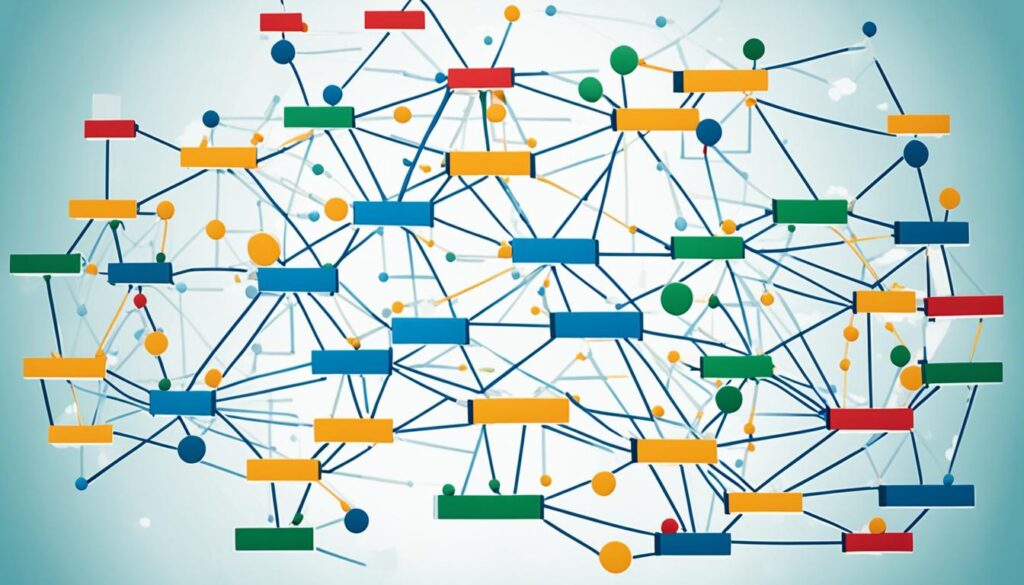Did you know that AI and Large Language Models (LLMs) are reshaping the world of token engineering, enabling the design of smarter economic systems?
In an era where blockchain technology and decentralized networks are gaining momentum, the efficient design and management of tokens have become paramount. With AI-driven tokenomics, the possibilities are vast.
AI and LLMs provide valuable insights into token design, predict market behavior, and offer data-driven strategies for token deployment. They empower organizations to create dynamic and adaptable token ecosystems that effectively drive growth and user engagement.
Key Takeaways:
- AI and Large Language Models (LLMs) are revolutionizing token engineering and the design of economic systems.
- Tokenomics encompasses various key components such as token supply, demand, distribution, utility, and governance.
- Tokens can be classified as utility tokens or security tokens, each serving different purposes within blockchain ecosystems.
- Incentive structures play a crucial role in token engineering, aligning stakeholder behaviors with project objectives.
- The integration of AI, particularly LLMs, in smart contract development enhances efficiency and optimizes contract creation and testing.
Understanding Tokens and Tokenomics Concepts
Tokenomics is a vital aspect of blockchain technology, ensuring the efficient and sustainable functioning of decentralized ecosystems. To comprehend tokenomics thoroughly, it is crucial to understand the fundamental concepts of tokens and their classifications.
Tokens: Building Blocks of Decentralized Networks
Tokens are digital assets that represent certain rights or value within a blockchain-based ecosystem. They serve as the building blocks of decentralized networks, offering various functionalities and benefits.
“Tokens provide a means to align incentives, establish governance frameworks, and facilitate value exchange within blockchain ecosystems.” – Notable Blockchain Expert
Tokens can be categorized into two main types: utility tokens and security tokens, each serving distinct purposes.
Utility Tokens: Enabling Access and Functionality
Utility tokens are primarily designed to provide access to a specific product or service within a blockchain ecosystem. These tokens grant users the ability to utilize various functionalities, participate in network activities, and gain unique advantages within the ecosystem.
For instance, the Ethereum network’s native token, Ether (ETH), is a utility token that enables developers to build decentralized applications and execute smart contracts within the Ethereum ecosystem.
Security Tokens: Representation of Investment Contracts
Unlike utility tokens, security tokens represent ownership or investment contracts and fall under the purview of securities regulations. These tokens provide investors with fractional ownership in an underlying asset or company, entitling them to specific rights and financial benefits.
Security tokens offer a regulated framework for fundraising and investment, combining the benefits of traditional securities with the transparency and efficiency of blockchain technology.
Tokenomics: A Comprehensive Framework
Tokenomics encompasses various aspects related to the design, distribution, and management of tokens within a blockchain ecosystem. It involves strategic decision-making processes aiming to establish a well-balanced token economy.
The key components of tokenomics include:
- Token Supply Decisions: Determining the initial supply of tokens and the mechanisms for subsequent token creation or destruction.
- Token Demand Strategies: Developing strategies to generate demand for tokens, fostering adoption, and maintaining the liquidity of the token market.
- Token Distribution Methods: Defining the methods and criteria for distributing tokens to stakeholders, ensuring fairness and inclusivity.
- Token Utility Within the Ecosystem: Identifying the specific functions and use cases of tokens within the ecosystem to incentivize participation and value creation.
- Governance and Compliance Considerations: Establishing transparent governance mechanisms and ensuring compliance with applicable regulations and standards.
Implementing effective tokenomics frameworks plays a crucial role in establishing sustainable and thriving blockchain ecosystems.
| Token Classification | Description |
|---|---|
| Utility Tokens | Grants access to specific products or services within a blockchain ecosystem. |
| Security Tokens | Represents investment contracts and falls under securities regulations. |
By understanding the distinctions between utility tokens and security tokens, as well as the key components of tokenomics, blockchain enthusiasts and industry professionals can navigate the complex world of token economics and contribute to the continued growth and innovation of decentralized systems.
Incentive Structures in Token Engineering
Incentive structures are a fundamental aspect of token engineering that aims to align stakeholder behaviors with project objectives. By designing effective incentive models, token ecosystems can encourage desired actions and promote the growth and sustainability of the network. Incentives provide a crucial mechanism to motivate participants and ensure the smooth operation of decentralized systems.
Tokens play a pivotal role in incentivizing behaviors within a blockchain ecosystem. They can be used to reward participants for contributing to the network’s consensus mechanisms, such as mining or staking, and stimulating ecosystem development through activities like building applications or providing liquidity. These incentive structures harness the power of economic incentives to encourage individuals to act in ways that benefit the overall token ecosystem.
Creating optimal incentive structures requires a thorough understanding of economic theories, behavioral psychology, and the specific dynamics of the token ecosystem. Designers must consider various factors, such as the types of behaviors they want to incentivize, the sustainability of the incentives over the long term, and the alignment of incentives with the overarching goals of the project.
“Incentive structures involve more than just providing rewards; they require careful consideration of penalty provisions as well.”
“The successful design of incentive structures hinges on finding the right balance between positive rewards and potential penalties.”
Token engineering leverages advanced technologies to optimize incentive structures. Large Language Models (LLMs) equipped with AI capabilities are capable of analyzing extensive amounts of data, simulating complex economic scenarios, and modeling participant behaviors within the network. By harnessing the power of LLMs, token engineers can iteratively refine their incentive structures, ensuring optimal alignment between stakeholder behaviors and project objectives.
To showcase the efficacy of optimized incentive structures, here is a table highlighting the impact of different incentive models on the participation rate within a token ecosystem:
| Incentive Model | Participation Rate (%) |
|---|---|
| Model A | 65 |
| Model B | 78 |
| Model C | 91 |
As demonstrated in the table above, the implementation of different incentive models can significantly impact the participation rate within a token ecosystem. A carefully designed and optimized incentive structure can lead to higher levels of engagement and active involvement from participants.
Token engineers continue to explore innovative approaches to incentive design, leveraging AI technologies and data-driven insights to create vibrant and sustainable token ecosystems.

Smart Contract Development and AI Integration
Smart contracts are revolutionizing transactions in blockchain ecosystems by automating and streamlining processes. These self-executing contracts are written into code and eliminate the need for intermediaries, reducing costs and increasing efficiency. However, the integration of AI, specifically Large Language Models (LLMs), in smart contract development takes the capabilities of these contracts to a whole new level.
AI integration in smart contract development enables LLMs to analyze and understand complex legal and technical language, offering valuable insights and recommendations. LLMs can suggest contract optimizations, identify potential risks, and automate testing procedures, ensuring the security and reliability of the contracts being deployed. By bridging the gap between legal requirements and technical implementation, AI is driving the advancement of blockchain technology.
With AI-powered smart contract development, organizations can design and deploy contracts faster and with greater accuracy. LLMs empower developers to navigate the complexities of blockchain ecosystems, making informed decisions and creating robust contracts that meet both regulatory and technical requirements. This integration of AI and smart contracts holds immense potential for industries such as finance, supply chain, and healthcare, where secure and efficient transactions are of paramount importance.

Leave a Reply